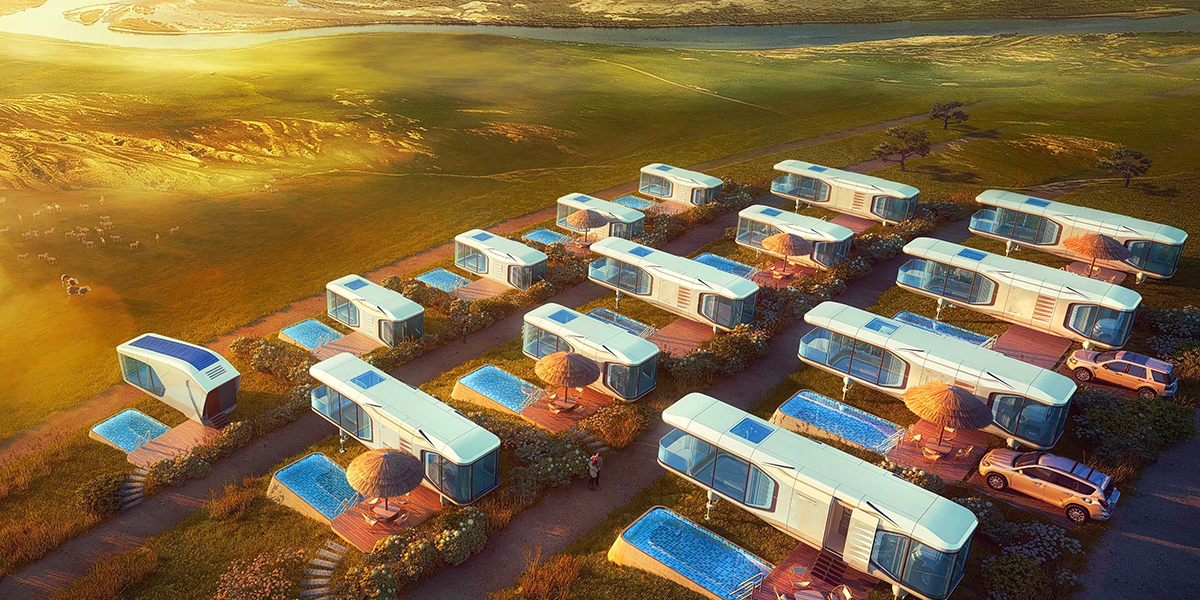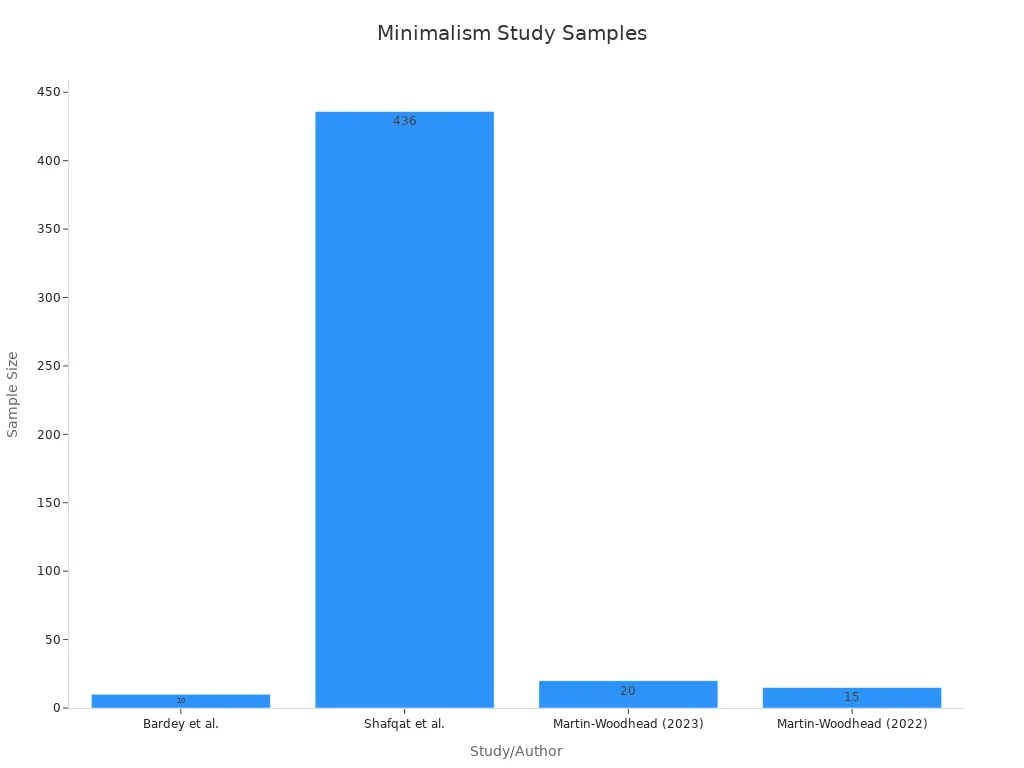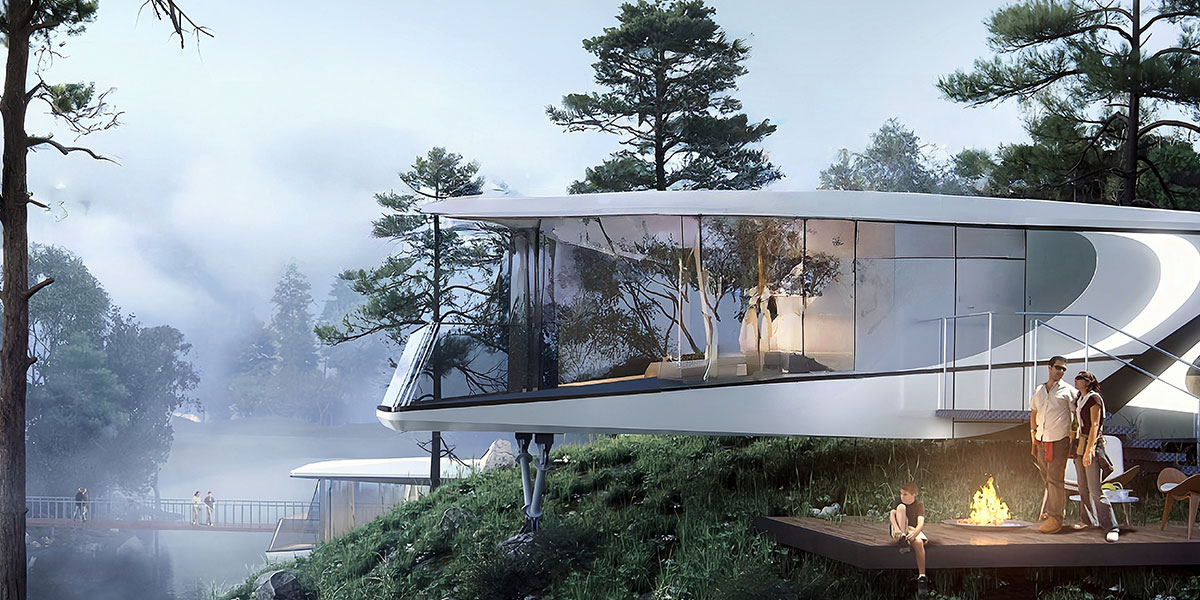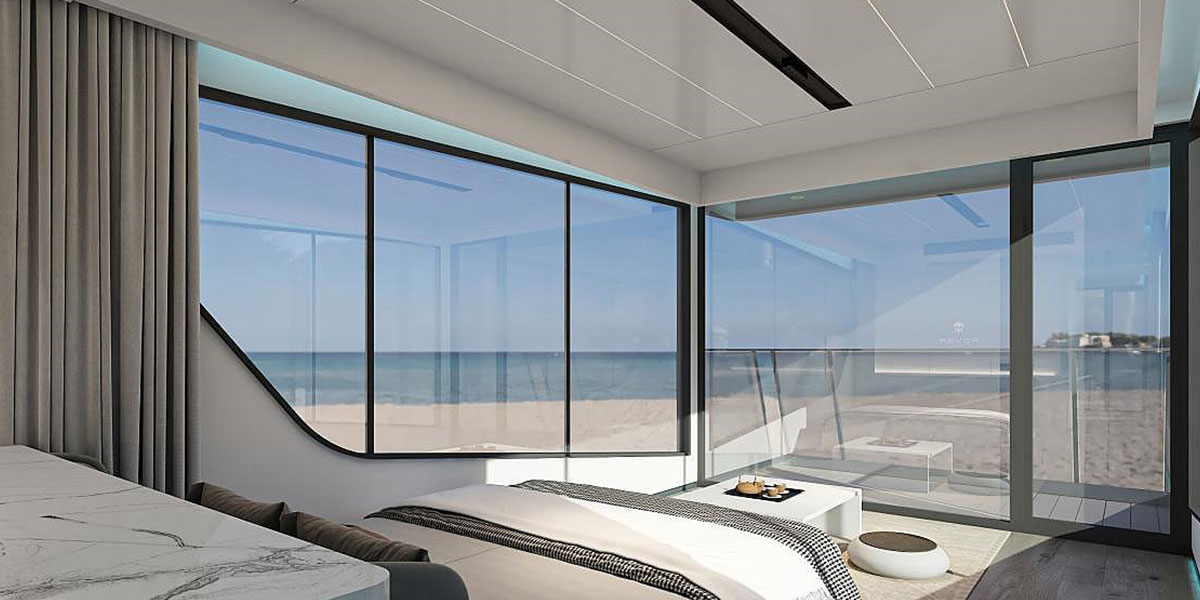
03 Jul The Sustainable Solution of Capsule Homes
Table of Contents
A capsule home gives you a small and flexible place to live. It looks modern and cool. Designers look at space capsules for ideas. They make homes that use space very well. Capsule homes have smart designs, so you get everything you need in a small spot. These homes often use green materials and smart technology. You get a cheaper choice that saves energy and cuts down on waste. Capsule homes are a new and smart way to live. Each one is made to fit what you need.
Key Takeaways
Capsule homes give you a small, modern place to live. They use space well and work for many people. These homes use eco-friendly materials and smart technology. This helps save energy, cut down on waste, and protect the earth. Modular design lets you set up fast and add more space later. It also helps you save money compared to regular houses. Living in a capsule home helps you live simply. It lowers your costs and keeps things tidy. Before you pick a capsule home, check local laws. Think about how much space you need and your budget. Make sure it fits your life.
Capsule Home Basics
What Is a Capsule Home?
A capsule home is a new way to live. It gives you a small space with everything you need. Designers use ideas from space capsules. They want you to feel like you live in a modern pod. Capsule homes use every bit of space well. You can find them in cities, backyards, or faraway places. Many people call them capsule tiny houses because they are much smaller than normal homes. Sometimes, capsule houses are stacked or put next to each other. This saves space and helps more people live in crowded places.
Tip: If you want to try living small, a capsule house can help you have less stuff and more freedom.
Capsule Home Design
Capsule homes use a simple and modular design. You see smooth lines, round corners, and shapes that look new. Most capsule houses have a basic layout. There is a place to sleep, a small kitchen, a bathroom, and storage. Some capsule tiny houses have sliding doors or fold-up furniture to save space. You can move or stack these prefab houses easily. The design lets you add more units if you need more space. Capsule houses often use eco-friendly materials and systems that save energy. You help the earth when you pick a capsule house.
Here is a quick look at what capsule tiny houses usually have:
Feature | Description |
|---|---|
Shape | Rounded, pod-like, or rectangular |
Size | Usually 100-400 square feet |
Materials | Steel, wood, recycled panels, glass |
Furniture | Foldable beds, hidden storage, compact desks |
Utilities | Built-in plumbing, electric, and ventilation |
You can see that capsule tiny houses focus on being useful and comfy. You get all you need in a neat, small space.
How Capsule Homes Work
Capsule homes use new prefab house building methods. Most parts are made in a factory. You get a prefab house that is ready to set up. Hidular and Macohouse use strict checks and new technology. For example, ETONG uses safe steps and outside checks. They make sure your capsule house is safe and strong. Macohouse uses steel frames that last up to 50 years. Their capsule tiny houses use special designs and save energy.
You do not need a big team to build a capsule house. Workers use cranes and trucks to bring the prefab house to you. You can set up capsule tiny houses fast, sometimes in just a few days. Capsule Manufacturing uses 3D CAD design to plan every part. They make sure plumbing and wires fit just right. Skilled workers put the capsule house together in the factory. They follow UL rules for safe wiring and clean water. When your capsule home comes, it is ready to use.
Note: Capsule tiny houses give you a quick, clean, and easy way to start living small. You save time and skip the mess of normal building.
Capsule houses work for many people. You can use them as your main home, a guest house, or a tiny office. The modular design lets you add more capsule tiny houses if you need more space. You get a flexible and modern way to live in a small space.
Capsule Homes and Sustainability
 Eco-Friendly Materials
Eco-Friendly Materials
When you pick capsule homes with eco-friendly materials, you help the earth. Many sustainable capsule houses use recycled steel, bamboo, or old wood. These materials last long and do not hurt nature. Some walls are made from panels of recycled plastic or glass. Certain capsule homes use paints that do not give off bad chemicals. By choosing these homes, you use fewer resources. You show that small spaces can help the planet in big ways.
Energy Efficiency
Capsule homes are good for saving energy. The small space is easy to heat or cool. Many sustainable capsule houses have thick insulation and triple-pane windows. These things keep your home warm in winter and cool in summer. You can add solar panels or use LED lights to save more energy. Some capsule homes have smart thermostats to control the temperature. You get a home that saves money and helps the city stay green.
Tip: Some capsule homes use water-from-air condensers. This tool takes water from the air, so you get clean water without using more resources.
Reducing Carbon Footprint
Living in capsule homes lowers your carbon footprint. These homes use less land and fewer materials. By picking sustainable capsule houses, you help the environment. Many builders use local materials to cut down on shipping. You also use less water and energy each day. Capsule homes help you protect the earth. You support a green future for everyone.
Capsule House Functionality
Modularity and Setup
Capsule houses are easy to set up because of their modular design. Each capsule tiny house comes already built. You just put it where you want to live. If you need more space, you can add more capsules later. Some people start with one capsule tiny house. Later, they add another for a bedroom or office. This way, you can change your home as you need. It also saves you time.
- Modular prefab units help you finish your capsule house faster than a regular home.
- Some families say their capsule tiny houses took half the time to build as normal homes.
- You save money over time, even if the first price is high.
Here is a table that shows how modular capsule tiny houses help you:
Feature | Benefit |
|---|---|
Time Reduction | Prefab capsule houses cut building time by 30% to 60%. |
Cost Savings | Capsule tiny houses can be up to 20% cheaper than regular homes. |
Fast Assembly | You get less mess and less noise during setup. |
Environmental Benefit | Using capsules means less waste and fewer materials. |
Tip: You can move capsule tiny houses if you want a new view or location.
Utilities and Technology
Capsule houses use smart technology to make life easier. Most capsule tiny houses have plumbing, electric systems, and good air flow. You get all you need in a small space. Some capsule tiny houses use solar panels for power. Others use water-from-air systems for clean water. In many capsule houses, you can control lights and temperature with your phone. This makes your capsule tiny house feel modern and nice.
- Capsule houses often use LED lights and smart thermostats.
- You can add security cameras or smart locks to your capsule tiny house.
- Many capsule tiny houses have appliances that save energy.
Note: You do not need to worry about setting up utilities. Most capsule tiny houses come ready to use.
Lifespan and Maintenance
Capsule houses last a long time if you care for them. Many capsule tiny houses use steel frames or strong recycled materials. These materials help your capsule house stay safe in bad weather. You only need to do simple cleaning and checks to keep your capsule tiny house in good shape. If you see a problem, you can fix it fast because the design is simple.
- Capsule tiny houses need less work than big homes.
- You spend less money on repairs and cleaning.
- Some capsule houses can last up to 50 years with good care.
Remember: Regular checks help your capsule tiny house last longer and stay safe.
Affordable Living Benefits
 Cost Advantages
Cost Advantages
Capsule tiny houses help you save money in many ways. They cost less to buy than regular homes. The starting price is about $20,000, but some cost up to $100,000. This is much cheaper than most houses, which can cost over $200,000. You spend less because building is faster and needs fewer workers. These homes use less energy and green materials, so your bills are lower. You also pay less for taxes and insurance because the house is smaller.
Here is a table that shows how different costs make capsule tiny houses more affordable:
Cost Factor | Description and Impact on Affordability |
|---|---|
Initial Investment | Smaller homes and modular building mean you pay less at first. |
Utility Bills | Energy-saving systems and small size lower your bills. |
Property Taxes | Smaller homes mean you pay less in taxes. |
Land Acquisition | Land price changes by place; city land costs more. |
Zoning Laws and Permits | Rules and permits can add to your costs. |
Construction Labor | Prefab homes need less work, but custom ones may cost more. |
Building Materials | Green and strong materials may cost more at first but save money later. |
Utility Connections | Water, power, and sewage costs change; off-grid homes can save money. |
HVAC, Plumbing, Electrical | Fancy systems cost more but make life better and save energy. |
Furnishings and Appliances | Smart and energy-saving furniture and tools cost less over time. |
Maintenance and Repairs | Small homes are easier and cheaper to fix and keep clean. |
Resale Value | More people want small, green homes, so value may stay strong. |
Tip: Capsule tiny houses are great for first-time buyers, people who want to downsize, or anyone who needs a cheaper home in the city.
Minimalist Lifestyle
Living in capsule tiny houses helps you keep only what you need. You do not have space for extra stuff, so you buy less. Research shows that people who live simply spend less money and use things longer. You use furniture that does more than one job, which fits well in small spaces. This way of living saves money and makes less trash.
Studies say people who live simply make less pollution than most people. You help the earth and save money at the same time. Many people feel less stress and more happiness when they live in capsule tiny houses. They also say it is easier to make choices. The chart below shows that research supports the good things about living simply:

Note: Capsule tiny houses make it simple to save money and live with less every day.
Boosting Property Value
Capsule tiny houses can make your land worth more. You can put a tiny house on your land for guests or to rent out. This makes your property more useful and wanted. More people want small, green homes, so capsule tiny houses are popular. You can move your tiny house or use it in new ways, which keeps its value high.
Capsule homes give you a cheap, flexible, and modern way to live. As more people want affordable and green homes, capsule tiny houses are a smart choice. You get a home that saves money and helps you do well in the housing market.
Capsule Houses: Challenges
Space and Privacy
Living in a capsule house feels different than a regular home. The small design means you have less space for your things. Some people like the cozy feeling, but others find it hard to get used to. It can be tough if you stay for a long time. Privacy is sometimes a problem. Each capsule gives you your own spot, but noise and light from shared places can bother you.
- Capsule hotels like The Pod Hotel in New York City show that small spaces look cool but can feel tight.
- The Prime Pod Kyoto mixes new and old styles, but guests still share spaces, so privacy is not perfect.
- Bed and Breakfast Capsule Hotel in Amsterdam is friendly, but you hear more sounds because everyone is close.
Think about how much space and privacy you want before picking capsule houses or tiny homes.
Legal and Zoning Issues
Capsule houses have many legal and zoning problems. Many cities only let people build regular homes, so it can be hard to find a spot for a capsule house. Building codes often say rooms must be a certain size or have enough windows, but capsule houses may not fit these rules. Some places do not have clear rules for capsule houses, so getting permits can be tricky. Lenders may not want to give loans for capsule houses because they are not like normal homes.
Zoning laws can stop you from building capsule houses or tiny homes in some places.
Building codes may not match the special design of a capsule house.
Many owners say getting permits is one of the hardest parts.
Some cities are starting to change rules to help people who want capsule houses.
Tip: Always check local laws and talk to experts before you buy or build a capsule house.
Comfort and Lifestyle Adjustments
Living in capsule houses or tiny homes means you must change your daily habits. You have less room for furniture, clothes, and hobbies. You may need to share some spaces with others, especially in a capsule hotel or group of capsule houses. Some people enjoy the simple life, but others miss the comfort of a bigger home.
You can make your capsule house nicer by picking smart furniture and keeping things neat. Over time, living with less can help you focus on what matters most. Still, moving into capsule houses or tiny homes takes time and patience.
Choosing Capsule Houses
Budgeting and Costs
When you plan for a capsule house, you need to think about more than just the price. Capsule house prices can start at $20,000 and go over $100,000 if you want more features or new technology. You also need to save money for land, bills, insurance, and repairs. Most people use personal loans or home equity lines because banks do not always give special loans for capsule homes. Saving money ahead of time helps you avoid problems and keeps your money safe.
- The tiny house market grows about 7.5% each year. More people want homes that are green and cost less.
- Where you put your capsule house matters. Homes in cities or near nature keep their value better.
- Good design and smart features make more people want to buy your home and can help you sell it for more.
- Experts say you should get an inspection before you buy to avoid big repair bills later.
Here is a table that shows how capsule houses and regular homes compare in cost:
Cost Aspect | Capsule Homes Details | Comparison to Traditional Homes |
|---|---|---|
Initial Cost | Prices start at $20,000 and can go over $100,000 if you want more features or new technology. | Usually cost more because they use heavier materials and take longer to build. |
Construction Savings | Light materials and modular design make building faster and cheaper. | Regular homes need more workers and materials, so they cost more. |
Energy & Water Bills | Small size means you use less energy and water, so your bills are lower. | Bigger homes usually have higher bills. |
Maintenance Costs | Strong materials like carbon fiber and aluminum mean fewer repairs; energy-saving systems lower bills. | Regular homes may cost more to fix because they use normal materials and systems. |
Long-Term Value | Capsule homes last a long time, can change with your needs, and may sell for more if people want them. | Regular homes have a set value but may cost more to keep up. |
Tip: Building a capsule house is fast and cheap, so you save time and money.
What to Consider
You should think about a few things before buying a capsule house. Start by looking at your budget and how much you can pay each month. Check if the land you want lets you put a capsule house there. Some places have rules that make it hard to build small homes. Look at the design and see if it works for you. Furniture that does more than one thing and smart layouts help you live better in a small space.
You also need to plan for future costs like repairs, upgrades, and insurance. Think about how easy it is to move or add more space later. Getting an inspection before you buy can help you find hidden problems. Make sure your money plan covers everything, not just the price of the house.
Is a Capsule House Right for You?
Ask yourself if you like living with less stuff. Capsule homes are best for people who want a simple life and want to save money. If you want lower bills and less cleaning, this kind of home could be good for you. You also help the earth by using fewer things. If you need a lot of space or privacy, a capsule house might not work for you. Think about your daily life and what is most important to you. If you want a home that is flexible, modern, and good for the planet, a capsule house could be a smart choice.
You have learned that capsule homes give you a smart way to live in a small space. These homes use modern designs and save you money. You get a flexible home that can fit your needs. Capsule homes offer a sustainable choice for the future. You may face some challenges, so always check your needs and do more research before you decide.
FAQ
What is the average size of a capsule home?
Most capsule homes range from 100 to 400 square feet. You get a compact space that fits a bed, bathroom, kitchen, and storage. This size helps you save energy and money.
Can you move a capsule home to a new location?
Yes, you can move many capsule homes. Builders design them to be portable. You use a truck or crane to relocate your home. This gives you flexibility if you want a new view or need to move.
How do you get water and electricity in a capsule home?
You connect your capsule home to local utilities, just like a regular house. Some models use solar panels or water-from-air systems. You can choose off-grid options if you want more independence.
Are capsule homes safe in bad weather?
Capsule homes use strong materials like steel and reinforced panels. You get protection from wind and rain. Some models meet strict safety codes. Always check the builder’s safety features before you buy.
Can you customize the inside of a capsule home?
You can pick layouts, colors, and furniture that fit your style. Many builders offer options for storage, lighting, and appliances. You make your capsule home feel unique and comfortable.




 Eco-Friendly Materials
Eco-Friendly Materials Cost Advantages
Cost Advantages